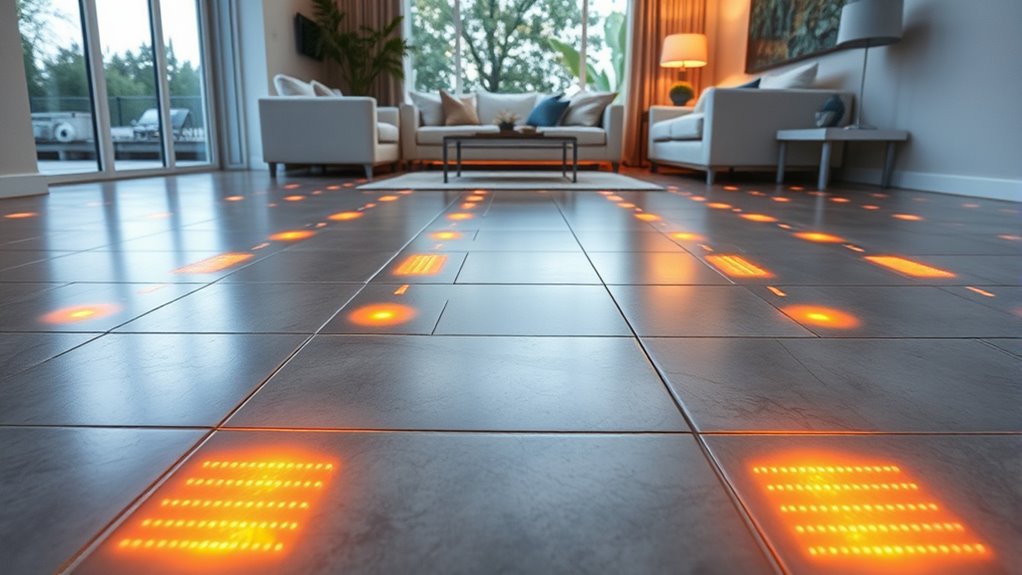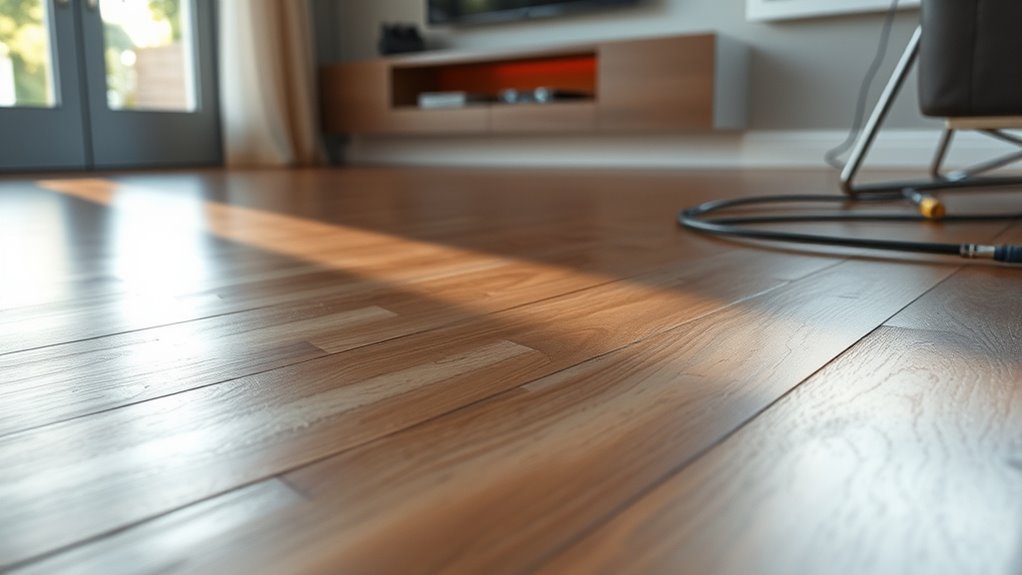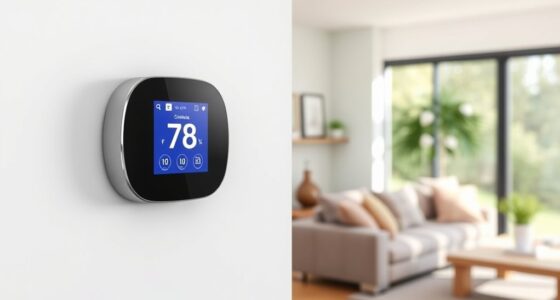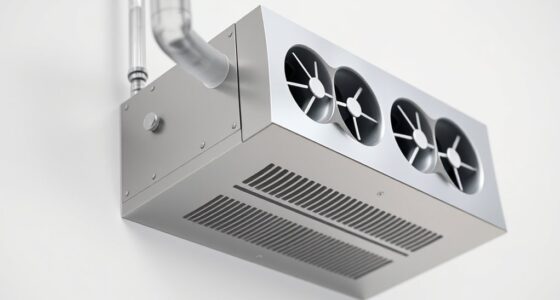Radiant floor heating provides even, energy-efficient warmth by heating your space from the ground up, eliminating cold spots and drafts. It’s quiet, improves indoor air quality, and allows you to lower thermostat settings to save energy. Installation costs vary based on system type and your flooring, with electric systems being simpler to retrofit. If you want to explore how this cozy, cost-effective heating option works and how to install it, you’ll find helpful details ahead.
Key Takeaways
- Provides even, comfortable heat distribution and improves indoor air quality by operating quietly without drafts.
- Offers energy savings by heating objects and people directly, reducing overall energy consumption.
- Installation costs vary: electric systems are affordable and easy to retrofit; hydronic systems are more cost-effective for large areas.
- Suitable flooring materials include tile, stone, and concrete; carpets may reduce system efficiency.
- Long-term benefits include consistent warmth, increased comfort, and reduced heat loss, enhancing indoor living quality.

Radiant floor heating offers an efficient and comfortable way to warm your home by delivering heat directly through the floor surface. This method heats a space more evenly than traditional forced-air systems, creating a cozy environment without cold spots or drafts. Because it radiates heat upward, it feels natural and soothing under your feet. When considering radiant heating, one of the main advantages is its energy efficiency. Since it heats objects and people directly, rather than the air, you can often set your thermostat lower and still enjoy a warm, comfortable space. This can lead to noticeable savings on your energy bills over time, especially if you’re replacing an older, less efficient heating system. However, it’s important to weigh the installation costs involved, as installing radiant floor heating can require significant upfront investment. The initial expenses depend on the system type you choose—electric or hydronic—and the complexity of your home’s flooring and existing infrastructure. Electric systems tend to have lower installation costs and are easier to retrofit into existing homes, making them suitable for small areas or renovation projects. Hydronic systems, which use heated water circulated through tubes, typically involve higher installation costs but can be more cost-effective in the long run for larger spaces or whole-house heating. The installation process itself can vary from straightforward to complex, depending on your home’s construction. For new builds, embedding the heating system beneath the subfloor is usually less disruptive and more seamless. In existing homes, retrofitting can involve removing or lifting floors, which adds to the overall costs and effort. Despite the initial investment, radiant floor heating offers long-term benefits, including reduced energy consumption and increased comfort. Its efficiency stems from the way it minimizes heat loss—since the heat stays close to the ground and rises naturally. Plus, because it operates quietly and doesn’t blow air around, it improves indoor air quality and creates a more peaceful environment. When planning your installation, it’s essential to factor in the type of flooring you have or want, as some materials conduct heat better than others. Tile, stone, and concrete are excellent choices, while carpets may reduce efficiency. Additionally, visual storytelling techniques can be used to showcase the benefits of radiant heating in marketing materials. Overall, radiant floor heating can be a smart, energy-efficient choice for your home, provided you’re prepared for the initial costs and work involved in installation. Once in place, it delivers consistent warmth, enhances comfort, and can save you money on energy bills for years to come.
Frequently Asked Questions
How Much Does Radiant Floor Heating Cost to Install?
You’ll likely spend between $6 to $20 per square foot to install radiant floor heating, depending on your home size and system type. The cost comparison shows hydronic systems are pricier but more efficient long-term. The installation process involves laying out the heating elements beneath the floor, which can be complex or straightforward depending on your existing flooring. Budget accordingly for professional installation to guarantee maximum performance and longevity.
Is Radiant Floor Heating Energy-Efficient Compared to Traditional Systems?
You’ll find radiant floor heating more energy-efficient than traditional systems since it uses less power and provides consistent warmth. Unlike forced-air systems, it works well with solar power and insulation techniques, reducing your energy bills. By distributing heat evenly, it minimizes waste and maximizes comfort. So, investing in radiant floor heating means you get a greener, cost-effective solution that maximizes energy savings and keeps your home cozy year-round.
Can Radiant Floor Heating Be Installed in Existing Homes?
Yes, you can install radiant floor heating in existing homes. You’ll want to explore retrofit options that suit your space, such as installing tubing beneath existing floors or using over-the-floor systems. Keep insulation considerations in mind, as proper insulation enhances efficiency and prevents heat loss. With careful planning and professional guidance, you can enjoy the comfort of radiant heat without major renovations.
What Types of Flooring Are Compatible With Radiant Heating?
While some flooring types lend themselves beautifully to radiant heating, others require a gentle touch through material considerations. You’ll find that ceramic tiles, stone, and porcelain are excellent choices, offering great flooring compatibility and efficient heat transfer. Conversely, carpets and thick hardwoods may need extra attention or specific underlayment. By carefully selecting materials, you guarantee your radiant heating system works seamlessly, providing cozy warmth without compromising your flooring’s beauty or durability.
How Long Does It Take to Heat a Room With Radiant Floor Systems?
You’ll notice the thermal response of radiant floor systems quickly, usually within 30 minutes to an hour. The heating speed depends on factors like insulation, room size, and system type. Once turned on, you’ll feel the warmth steadily increase, providing cozy comfort faster than traditional heating. For maximum efficiency, guarantee your system is properly installed and insulated, which helps achieve quicker heat distribution and maintains consistent temperature.
Conclusion
Installing radiant floor heating is like wrapping your home in a warm hug, offering comfort and efficiency all year round. With its energy savings and cozy glow underfoot, it’s a smart upgrade that transforms your living space into a haven of warmth. Once you understand the basics, you’ll see it’s a straightforward way to enjoy luxurious heating without the clutter of traditional systems. Embrace this radiant change and let your home shine with cozy warmth!









